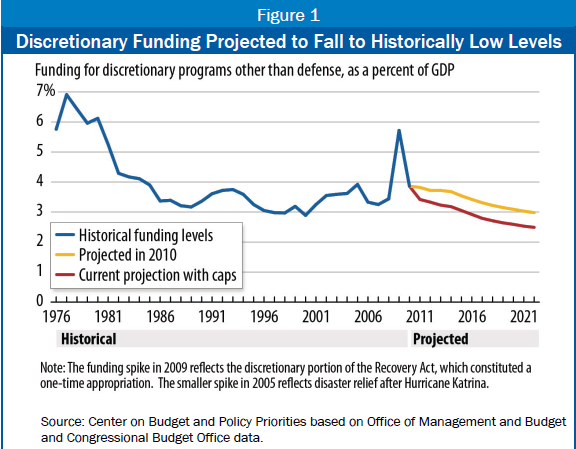There is a strongly held view -- one I've contributed to myself -- that our dysfunctional federal government cannot accomplish anything useful on the budget front. To the contrary, they can create recessionary cliffs, i.e., they're good at creating problems, not solutions.
Well, I spent the morning in a taped discussion with Senator Alan Simpson of the Simpson-Bowles fame (he said his name should go first so as to avoid the unflattering acronym if you go the other way). One of the points I tried to bring to the discussion -- which I'll post once it's public -- is that we've actually made progress, especially from his perspective, on spending cuts in the budget.
These developments are poorly understood by those -- most vocally, SB advocates -- who continuously inveigh that we're not "serious" about cutting spending. In fact, that's the only thing we've been "serious" about so far, such that we've actually achieved 70% of the discretionary spending cuts called for in the SB budget plan. This does not count war savings, nor does it include savings on interest payments, which would add another $250 billion to the savings.
Policymakers and budget experts generally agree on the need to reduce projected deficits and put the federal budget on a sustainable path. They have focused less attention, however, on the amount of deficit reduction that the 112th Congress and the President have enacted. Reductions in funding for discretionary (i.e., non-entitlement) programs enacted last year, primarily in the Budget Control Act, have produced $1.5 trillion in savings in discretionary spending for fiscal years 2013 through 2022. This part of the budget includes defense, international programs, and an array of domestic programs ranging from education to law enforcement, food safety, and environmental protection.
Two-fifths of the $1.5 trillion in savings from cutting and capping funding for discretionary programs comes from defense, while the other three-fifths comes from reductions in domestic and international programs. These reductions will shrink non-defense discretionary spending to its lowest level on record as a share of GDP, with data going back to 1962 (see figure).
I raise this for a few reasons. First, when people correctly point out that a sustainable budget path requires both spending cuts and tax increases, please point out to them that we have, in fact, already done a bunch of the former. It's fairly widely accepted these days that it will take about $4 trillion in cuts over 10 years to stabilize the debt, so we're about 38% of the way there on spending cuts alone. It's new revenue time.
I know -- the really "serious" cutters want to see cuts to the big social insurance programs. Well, the President has those too -- remember the $716 billion of Medicare savings targeted at providers that was the rage a few weeks ago (and that Gov. Romney says he'll restore)? But what about Social Security?
Look, as I stressed to Sen. Simpson, he and Bowles have done us a service by putting everything on the table. But you don't have to show your mettle by whacking the entitlements. That too should involve balance, a lot more, I'd argue, than we saw in SB re Social Security.
Finally, I've said it before and I'll say it again. What is so damn great about cutting the heck out of non-defense discretionary spending? Clearly, we want to evaluate their effectiveness, but in an age of increased inequality and diminished opportunity and mobility among the least advantaged, many of the programs in this category should be expanded (help with college assistance, Head Start, job programs and job training). Simply cutting for the sake of optics without regard to social need and economic context is not the way forward.

This post originally appeared at Jared Bernstein's On The Economy blog.
